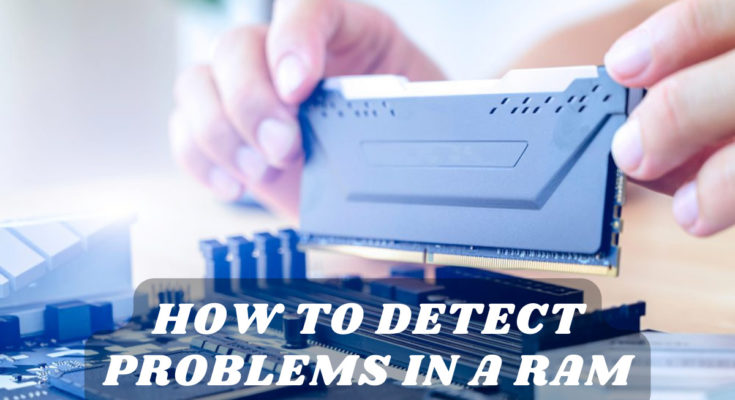There are several ways to detect problems in RAM (Random Access Memory). Here are a few common methods:
I. Memory diagnostics software:
Many software tools are available that can scan your computer’s RAM for errors. Memtest86+ is a popular and free memory diagnostic tool that you can download and run from a USB drive or CD.
II. Windows Memory Diagnostic Tool: Windows has its own built-in memory diagnostic tool that you can use to test your RAM. You can access this tool by searching for “Windows Memory Diagnostic” in the Start menu or by running “mdsched.exe” from the Run dialog.
III. Check for physical damage:
If you suspect that there might be physical damage to the RAM, you can try removing the RAM stick(s) and inspecting them for any signs of damage or corrosion. Also, make sure that the RAM sticks are properly seated in their slots.
IV. Check for system crashes:
If your computer crashes frequently or experiences the “blue screen of death,” it could be an indication of a RAM problem. These symptoms can be caused by bad RAM.
V. Check for corrupted files:
If you encounter corrupted files or experience programs crashing or freezing, it could be a sign of bad RAM. Try to isolate the problem by running the program that’s causing issues and checking if the issue still persists when running with only one RAM stick at a time.
VI. Check system logs:
Some operating systems log errors and warnings related to memory. You can check your system logs to see if there are any memory-related errors that may indicate a problem with your RAM.
If you suspect that your RAM is faulty, it’s important to replace it as soon as possible to avoid further damage to your system.
I. MEMORY DIAGNOSTICS SOFTWARE:-
Memory diagnostics software is a type of software tool that is used to test and diagnose problems with a computer’s RAM (Random Access Memory). These programs are designed to perform comprehensive tests on the RAM to identify any errors or issues that might be present.
Memory diagnostics software typically works by writing and reading data to and from the RAM in various patterns and combinations to test its reliability and performance. The software will report any errors it detects, such as incorrect data values or failed read/write operations.
There are many different memory diagnostics software programs available, including both free and paid options. Some popular examples include Memtest86+, Windows Memory Diagnostic, and PassMark MemTest.
Memory diagnostics software is often used by computer technicians and enthusiasts to troubleshoot issues with their systems, such as system crashes, freezes, or performance problems. By identifying problems with the RAM, users can take steps to replace faulty memory modules and restore their system’s stability and performance.
II. WINDOWS MEMORY DIAGNOSTICS TOOL:-
The Windows Memory Diagnostic tool is a built-in utility in Windows operating systems that allows users to test their computer’s RAM (Random Access Memory) for errors or issues. The tool works by writing and reading data to and from the RAM in various patterns to test its reliability and performance.
To use the Windows Memory Diagnostic tool, follow these steps:
Press the Windows key + R on your keyboard to open the Run dialog box.
Type “mdsched.exe” in the Run box and press Enter. This will open the Windows Memory Diagnostic tool.
You’ll be prompted to choose between two options: “Restart now and check for problems (recommended)” or “Check for problems the next time I start my computer.” Select the option you prefer.
If you choose to restart your computer immediately, the tool will run before the operating system loads. If you choose to run the tool on the next restart, the tool will run before the login screen appears.
The Windows Memory Diagnostic tool will perform several tests on your RAM, which may take several minutes to complete. During this process, you won’t be able to use your computer.
Once the tool has finished testing, your computer will restart automatically. If any errors are detected, the tool will display a message indicating that the RAM may be faulty.
If the Windows Memory Diagnostic tool detects errors, you should consider replacing the faulty RAM as soon as possible to avoid further issues with your system.
III. CHECK FOR PHYSICAL DAMAGE:-
Checking for physical damage is one way to detect problems in RAM (Random Access Memory). Here are the steps you can follow:
Power off your computer and unplug it from the power source.
Open your computer case to access the RAM modules. The location of the RAM modules will depend on your computer’s make and model, but they are typically located near the CPU and motherboard.
Carefully remove the RAM module from its slot. Make sure you’re grounding yourself by touching a metal surface to avoid static discharge that may damage the RAM.
Inspect the RAM module for any physical damage or signs of wear and tear. Look for cracks, scratches, or any other damage to the circuit board. Also, check the pins or connectors on the bottom of the module for any signs of corrosion or damage.
If you find any physical damage, the RAM module should be replaced. If there is no visible damage, reinsert the RAM module into its slot and ensure it’s properly seated. You can also try swapping the module to a different slot or using another module altogether to isolate the problem.
Note that physical damage is not always visible, and sometimes a damaged RAM module may appear to be fine. Therefore, if you’re experiencing issues with your RAM, it’s recommended to use a memory diagnostics software or other methods to test the RAM’s reliability and performance.
IV. CHECK FOR SYSTEM CRASHES:-
System crashes can be an indication of problems with RAM (Random Access Memory). Here are some steps you can follow to check for system crashes:
1. Open the Event Viewer: Click the Start button, type “Event Viewer” in the search box, and select the app from the results.
2. Navigate to the System logs: In the left pane of the Event Viewer, expand the Windows Logs folder and select the System folder.
3. Look for critical and error events: In the middle pane, look for events with a “Critical” or “Error” level. These events can be an indication of system crashes or other errors.
4. Check the event details: Double-click on the event to view its details. Look for any information related to the crash, such as the source of the error, error codes, and any other relevant details.
5. Check for patterns: Look for patterns in the events. If you notice multiple events occurring at around the same time or at regular intervals, it may indicate a problem with your RAM or other hardware.
6. Use memory diagnostics software: If you suspect that RAM is the cause of the crashes, use memory diagnostics software such as Windows Memory Diagnostic, Memtest86+, or PassMark MemTest to test the RAM for errors.
By following these steps, you can check for system crashes and determine whether they are related to problems with your RAM or other hardware. If you suspect that your RAM is the cause of the crashes, you should replace the faulty RAM module to avoid further issues with your system.
V. CHECK FOR CORRUPTED FILES:-
Corrupted files can also be an indication of problems with RAM (Random Access Memory). Here are some steps you can follow to check for corrupted files:
1. Open the Command Prompt: Click the Start button, type “cmd” in the search box, right-click on “Command Prompt” in the results, and select “Run as administrator.”
2. Run the System File Checker (SFC) tool: In the Command Prompt window, type “sfc /scannow” and press Enter. This will scan your system for corrupted files and attempt to repair them.
3. Check the scan results: After the scan completes, check the results to see if any corrupted files were found and repaired. If any corrupted files were found but not repaired, you may need to perform additional steps to fix the issue.
4. Run the Deployment Image Servicing and Management (DISM) tool: In the same Command Prompt window, type “DISM /Online /Cleanup-Image /RestoreHealth” and press Enter. This will repair any issues with the system image files.
5. Use memory diagnostics software: If the SFC and DISM tools don’t fix the issue, use memory diagnostics software such as Windows Memory Diagnostic, Memtest86+, or PassMark MemTest to test the RAM for errors. Corrupted files can be a symptom of RAM issues, and testing the RAM can help you identify if this is the root cause of the problem.
By following these steps, you can check for corrupted files and determine whether they are related to problems with your RAM or other hardware. If you suspect that your RAM is the cause of the corrupted files, you should replace the faulty RAM module to avoid further issues with your system.
System logs can provide valuable information about any issues or errors occurring on your computer, including those related to RAM (Random Access Memory). Here are the steps you can follow to check system logs:
VI. CHECK SYSTEM LOGS:-
1. Open the Event Viewer: Click the Start button, type “Event Viewer” in the search box, and select the app from the results.
2. Navigate to the System logs: In the left pane of the Event Viewer, expand the Windows Logs folder and select the System folder.
3. Check for events: In the middle pane, look for events related to memory, such as “Memory Diagnostics” or “Kernel-Power”. You can also look for events with an “Error” or “Warning” level, which may indicate issues with your RAM or other hardware.
4. Check the event details: Double-click on an event to view its details. Look for any information related to the event, such as the source of the error, error codes, and any other relevant details.
5. Check for patterns: Look for patterns in the events. If you notice multiple events occurring at around the same time or at regular intervals, it may indicate a problem with your RAM or other hardware.
6. Use memory diagnostics software: If you suspect that RAM is the cause of the errors, use memory diagnostics software such as Windows Memory Diagnostic, Memtest86+, or PassMark MemTest to test the RAM for errors.
By following these steps, you can check system logs to determine whether there are any issues or errors related to your RAM or other hardware. If you suspect that your RAM is the cause of the errors, you should replace the faulty RAM module to avoid further issues with your system.



